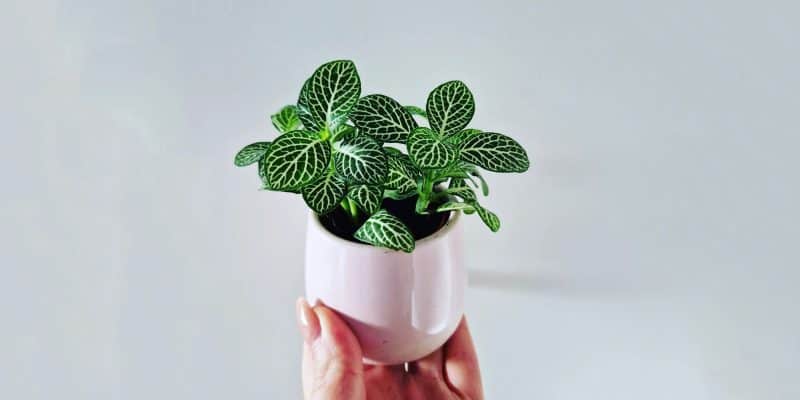The Nerve Plant, or Fittonia, is a true showstopper.
With its dark green leaves dramatically adorned with pink, red, or white veins, the Nerve Plant is a popular choice for houseplant experts and novice green thumbs alike.
While the patterns on its leaves are intricate, caring for this plant isn’t so complex! And when grow indoors, it will reward your efforts with lush growth and stunning visuals.
We’ll hit on all aspects of Nerve Plant care, from watering guidelines to perfect potting conditions. Let’s discover all there is to know about this vivid houseplant!
Table of Contents
Nerve Plant Care Guide
History, Habitat, and Characteristics
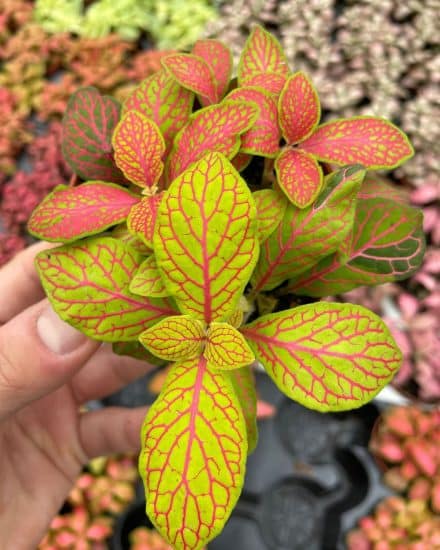
The Nerve Plant, or Fittonia albivenis, is a stunning tropical species with eye-catching deep green leaves that come with vein variations of green and pink, white, or red. In fact, it’s also known as the Mosaic Plant, Net Plant, or Painted Net Leaf because of its colorfully intricate net-like leaf patterns.
The Fittonia is native to the tropical rainforests of South America. It comes from a very humid environment with low light, requiring moist air to thrive. This makes it an ideal candidate for terrariums or bottle gardens. But don’t worry – it’s a slow grower, so you won’t be swamped by its leafy charm!
Nerve Plants are also non-toxic to humans and animals, so when you grow these as indoor plants, you can breathe easy knowing your family and furry friends are safe.
Fun fact: The genus Fittonia was named after Elizabeth and Sarah Mary Fitton, two Irish sisters and botanists who defied Victorian norms in the 1800s to make their mark in the world of plants.
Light
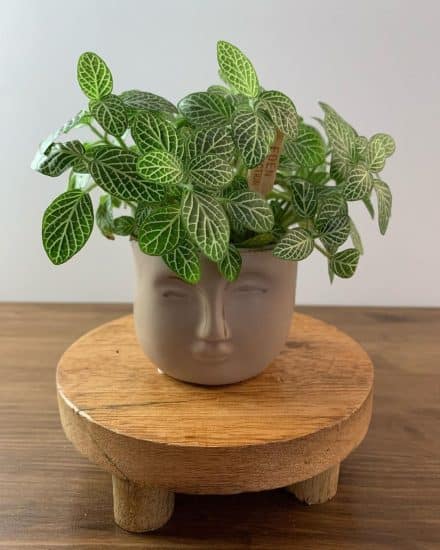
As tropical houseplants, Fittonia plants love bright light, but indirect sun only. An east-facing window is perfect for providing plenty of morning sunlight without the heat of the afternoon sun. For west-facing windows, it’s a good idea to keep the Nerve Plant away from the glass to avoid sunburn.
While this plant can handle some shade, you’ll notice slow growth, leggy stems, or the leaves losing their beautiful color if it is not getting enough light.
On the flip side, too much light can cause burned or scorched leaves, brown and curling leaf edges, and a general loss of that eye-catching color.
Lighting tips:
- Place your Nerve Plant in an east-facing window for an ideal balance of morning sunlight without the heat of the afternoon sun.
- If you’d like to put your plant near a west-facing window, avoid sunburn by keeping it slightly away from the glass or using a sheer curtain to block out the harshest rays of the sun.
- If you’re having trouble getting enough sunlight to your Nerve Plant, try an LED grow light as an artificial light source.
Water
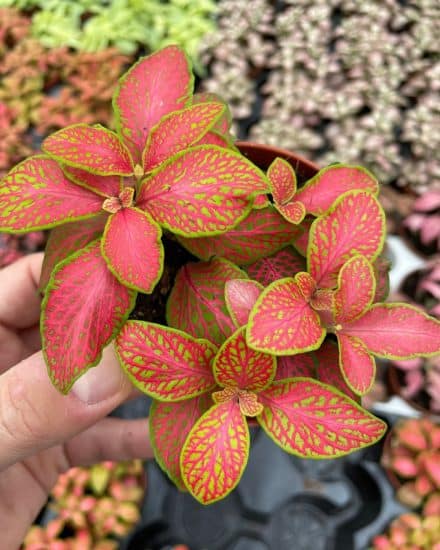
The Nerve Plant, or Mosaic Plant, likes to be kept fairly moist. You’ll want to water it when the top layer of soil feels dry, which can be every 2 or 3 days depending on the size of its pot, the temperature, and amount of sunlight it’s getting.
Be sure to let it dry out a little between waterings, and steer clear of using icy cold water — it might shock those delicate shallow roots.
Not enough water may lead to your Nerve Plant wilting or looking a bit droopy. But don’t worry, it’s a fighter! Once you give it a healthy dose of water, it’ll spring back to life.
On the flip side, too much water could lead to issues like root rot. If you spot yellow, mushy leaves or find the soil staying consistently wet, reduce your watering frequency to let it dry out a bit more between waterings.
Temperature and Humidity
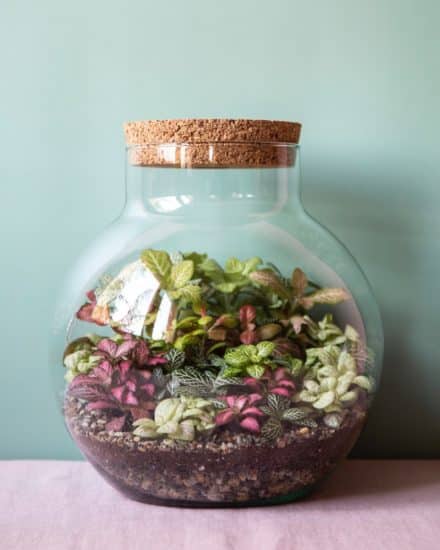
Nerve Plants grow best in a temperature range of 60-80°F (15-25°C). To keep them cozy and protected, maintain a distance from sources of drafts and chilly windows, and avoid drastic temperature fluctuations.
If the temperature is too high, the leaves may wilt and lose their vibrant green foliage. If it’s too low, you might notice slowed growth or even damage to the plant.
As tropical plants, Nerve Plants prefer high humidity levels of 60-70% that matches the environment in the tropical rainforests they hail from. Placing them in a kitchen or bathroom where humidity is naturally higher is a great idea, as long as there’s enough light. Alternatively, boost the humidity by using a pebble tray beneath your plant, or placing a humidifier nearby.
When it comes to humidity, Fittonia plants can be sensitive to too much or too little moisture. If you notice the leaves turning yellow or browning at the edges, the humidity may be too high.
Conversely, curling or shriveled leaves are a sign that the humidity might be too low.
Soil and Planting
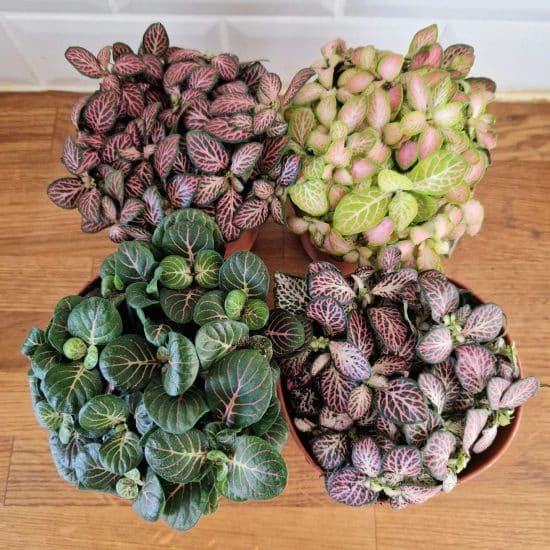
Nerve Plants need a well-draining soil that also does a good job of retaining moisture. The wrong potting mix can lead to leaves wilting, yellowing or developing brown tips.
Adding coco coir and/or perlite to an all-purpose soil mix will enhance air circulation and moisture retention, promoting healthy Nerve Plant growth.
Make sure your plant’s pot has adequate drainage holes. You can catch excess water by using a saucer beneath the pot but dump the water out as soon as it collects to prevent waterlogging. You can also improve aeration by gently loosening the soil with a chopstick or pencil before watering.
Fertilizer
Nerve Plants enjoy being fed weekly when they’re actively growing, usually in the late spring and early summer months. An all-purpose fertilizer, applied at a diluted strength, works well for these tropical houseplants.
Signs of too much fertilizer can include leaf burn, slow growth, and yellowing leaves. If you spot these symptoms, flush the soil with water to wash out excess fertilizer and reduce the frequency or concentration of future fertilizer applications.
Propagation
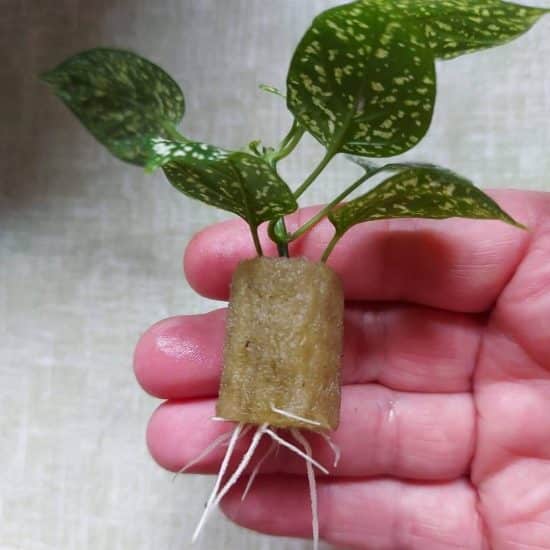
With our handy tips and tricks, you’ll be growing new Nerve Plants from stem cuttings in no time.
Propagate Nerve Plant via stem cuttings:
- Pick the perfect stem: Select a strong, mature stem with four or five fabulous, healthy leaves.
- Snip the stem: Grab some sterile scissors or pruning shears and cut the chosen stem at a 45° angle. This increases the surface area for roots to grow, helping your cutting to soak up water like a champ!
- Prep your cutting: Gently remove the leaves from the bottom two inches of the stem.
- Plant your cutting: Pop the cut end of the stem into well-draining soil. Give the soil a gentle pat to hold the cutting in place.
- Create a cozy environment: Place a clear plastic bag, or the bottom of a cut-off plastic bottle, over the cutting to create a nifty greenhouse effect that will promote root development.
- Take care of your cutting: Keep your little plant baby in a warm, humid spot away from cold temperatures, with bright, indirect light. Keep the soil consistently moist, but not soaking wet. In a few weeks, roots should start developing, and you’ll see some fresh new growth.
Our propagation tips:
- Propagating Nerve Plants can be a bit of a challenge, and you might not have success on your first try. Stay positive, and don’t be disheartened if you need to try a couple of times.
- Humidity and moisture are key until your cutting gets established. Just be careful not to go overboard and cause rot by keeping the soil too wet!
- Timing is everything. Your best bet for successful propagation is during the growing season (spring and summer), when your Nerve Plant is full of energy for developing new roots and shoots.
Common Issues
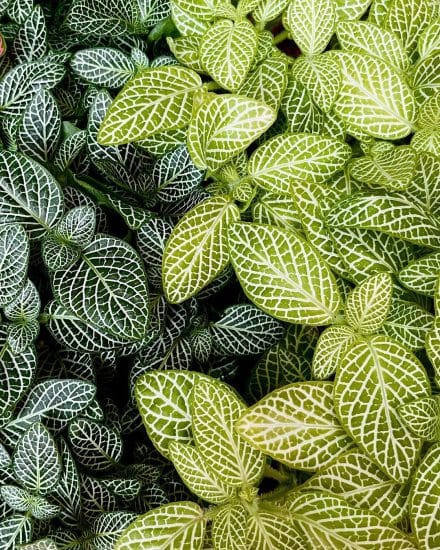
Seeing Nerve Plant problems like yellowing or wilting leaves? Here’s how to troubleshoot and fix them.
Yellowing Leaves
There are a couple of reasons you might be seeing leaves that are yellowing, drooping, or even falling off your Net Plant. One is overwatering — Fittonia plants can be a bit sensitive when it comes to how much water they’re given.
So, how do you know if overwatering is the issue? Check if the soil feels constantly soggy and look out for signs of rot.
To address this issue, let the soil dry out a bit more between waterings, and make sure the pot has good drainage holes. If the issue persists, you might need to repot your Nerve Plant in a mix with better drainage.
On the other hand, drooping leaves can also be a sign of underwatering. In this case, just give it a good soak, and it’ll bounce back in no time.
Wilting Leaves
We’ve mentioned that underwatering could be a culprit, but there’s another reason your Nerve Plant’s leaves could be wilting — not enough sunlight. If your plant is sitting in a spot that’s just too dim, it might start to show its disappointment with wilted leaves.
Move it closer to a window, but be sure to use a sheer curtain if the spot gets direct sun. Keep an eye on its progress, and if needed, keep adjusting the location until your plant friend is thriving again.
In the winter months, you may need to provide additional light to keep it growing strong. Don’t forget to maintain warm temperatures and humid conditions to mimic its natural tropical climate!
Pests and Diseases
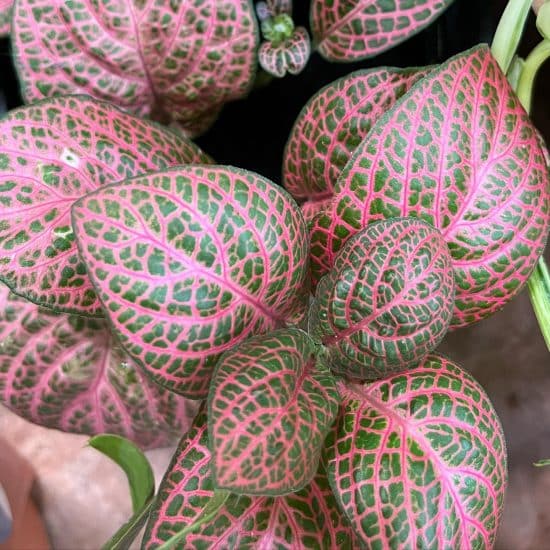
We’re here to help you identify and tackle the most common pests your Nerve Plant might face.
Fungus Gnats
If your Nerve Plant is looking a bit down in the dumps, with yellowing leaves and a wilted appearance, these tiny annoyances might be the culprits.
These pests are drawn to damp soil conditions, which also encourage the growth of fungi that provide a food source for the gnats. So, if you have fungus gnats, it’s likely due to overwatering, poorly draining soil, or soil compaction.
If you see these tiny gnats around your Nerve Plant, give it a new lease on life with fresh, well-draining soil (throw in some perlite, pumice, or LECA to boost aeration).
Their larvae feed on plant roots, so if you notice damaged roots while you’re changing out the soil, be sure to trim those away in the process. And, of course, make sure the pot has proper drainage holes.
To prevent this sad situation from happening again, let the soil dry out more between waterings.
Other Pests
Spider Mites: These tiny troublemakers can make your Nerve Plant look sick, with yellowing and speckled leaves. If you spot fine webbing on the leaves and stems, you’ve got yourself a spider mite infestation.
Spider mites thrive in dry conditions, so raising the humidity will help fend them off. You can also apply neem oil (a natural insecticide) to the leaves, according to the label instructions. Remember to isolate the affected plant from others and treat the undersides of the leaves as well as the tops.
Mealybugs: If you see small white cotton-like fluff on your Nerve Plant’s stems and a few leaves, that’s the work of mealybugs. Get rid of them by dabbing a cotton swab soaked in rubbing alcohol or use a mild dish soap solution. Follow up with neem oil for good measure.
Aphids: These green or black nuisances can make your Nerve Plant’s leaves curl up and look rather odd. To send them packing, spray your plant with a water and dish soap mix, or use an insecticidal soap.
To keep your Nerve Plants pest-free in the future, regularly inspect the leaves and stems for any signs of unwanted visitors. Catching pests early is the key to keeping these tropical plants happy and healthy!
Conclusion
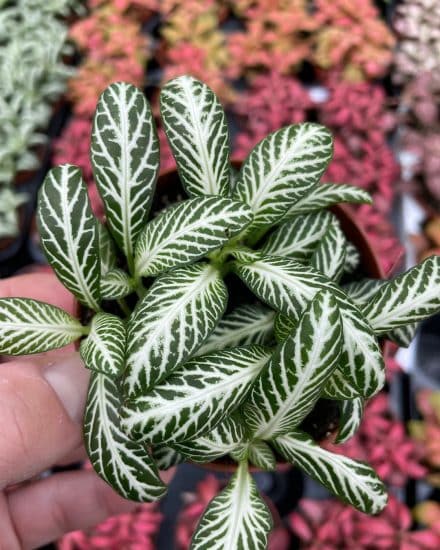
That’s a wrap for our Nerve Plant guide!
With the right care, your Nerve Plant’s stunning green leaves will steal the show (those red, white, and pink veins can’t be ignored).
Nerve Plant Guide Summary:
- Provide bright light but avoid direct sun which can easily burn those beautiful leaves.
- Keep the soil consistently moist but avoid waterlogging by letting your Nerve Plant dry out slightly between waterings.
- Maintain moderately warm temperatures and high humidity levels. To increase humidity, try using a humidifier or pebble tray beneath the plant.
- Use a soil mix that retains moisture but also drains well by incorporating coconut coir or perlite to an all-purpose mix. Improve drainage further by adding in LECA or pumice.
- Fertilize Nerve Plants regularly during the growing season, following instructions on the label.
We hope you’re now well-equipped to care for this vivid tropical plant. If you have any questions or need further assistance with your Nerve Plant, please don’t hesitate to reach out to us.
Good luck, and happy planting!
FAQ
Why is it called the Nerve Plant?
The Nerve Plant gets its name from the intricate, net-like patterns on its deep green leaves. These tiny veins have a visually captivating effect that has earned it other monikers like the Mosaic Plant and Painted Net Leaf.
Should I mist my Nerve Plant?
Yes, you absolutely can mist your Nerve Plant, but it doesn’t do much to raise the humidity. You can give it a gentle spray of water every few days; just make sure you wipe the leaves down after to prevent any pests or diseases.

